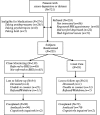A randomized controlled trial of a close monitoring program for minor depression and distress
- PMID: 18498013
- PMCID: PMC2518035
- DOI: 10.1007/s11606-008-0663-4
A randomized controlled trial of a close monitoring program for minor depression and distress
Abstract
Background: Minor depression is almost twice as common in primary care (PC) as major depression. Despite the high prevalence, few evidence-based algorithms exist for managing patients with minor depression or patients presenting solely with distress.
Objectives: The aim of this study was to test the effectiveness of a telephone-based close monitoring program to manage PC patients with minor depression or distress.
Design: Subjects were randomly assigned to either the control arm (usual care; UC) or the intervention arm (close monitoring; CM). We hypothesized that those randomized to CM would exhibit less depression and be less likely to have symptoms progress to the point of meeting diagnostic criteria.
Subjects: Overall, 223 PC subjects with minor depression or distress consented to participation in this trial.
Measurements: At baseline, subjects completed a telephone-based evaluation comprised of validated diagnostic assessments of depression and other MH disorders. Outcomes were assessed at six months utilizing this same battery. Chart reviews were conducted to track care received, such as prescribed antidepressants and MH and primary care visits.
Results: Subjects in the CM arm exhibited fewer psychiatric diagnoses than those in the UC arm (chi(2) = 4.04, 1 df, p = 0.04). In addition, the intervention group showed improved overall physical health (SF-12 PCS scores) (M = 45.1, SD = 11.8 versus M = 41.5, SD = 12.4) (chi(2) = 5.90, 1 df, p = .02).
Conclusions: Those randomized to CM exhibited less MH problems at the conclusion of the trial, indicating that the close monitoring program is effective, feasible and valuable. The findings of this study will allow us to enhance clinical care and support the integration of mental health services and primary care.
References
-
- {'text': '', 'ref_index': 1, 'ids': [{'type': 'PubMed', 'value': '8877487', 'is_inner': True, 'url': 'https://pubmed.ncbi.nlm.nih.gov/8877487/'}]}
- Beck DA, Koenig HG. Minor depression: a review of the literature. Int J Psychiatry Med. 1996;26:177–209. - PubMed
-
- {'text': '', 'ref_index': 1, 'ids': [{'type': 'PubMed', 'value': '8008797', 'is_inner': True, 'url': 'https://pubmed.ncbi.nlm.nih.gov/8008797/'}]}
- Crum RM, Cooper-Patrick L, Ford DE. Depressive symptoms among general medical patients: prevalence and one-year outcome. Psychosom Med. 1994;56:109–17. - PubMed
-
- {'text': '', 'ref_index': 1, 'ids': [{'type': 'PubMed', 'value': '10533546', 'is_inner': True, 'url': 'https://pubmed.ncbi.nlm.nih.gov/10533546/'}]}
- Pincus HA, Davis WW, McQueen LE. ‘Subthreshold’ mental disorders. A review and synthesis of studies on minor depression and other ‘brand names’. Br J Psychiatry. 1999;174:288–96. - PubMed
-
- {'text': '', 'ref_index': 1, 'ids': [{'type': 'DOI', 'value': '10.1001/jama.267.11.1478', 'is_inner': False, 'url': 'https://doi.org/10.1001/jama.267.11.1478'}, {'type': 'PubMed', 'value': '1538538', 'is_inner': True, 'url': 'https://pubmed.ncbi.nlm.nih.gov/1538538/'}]}
- Johnson J, Weissman MM, Klerman GL. Service utilization and social morbidity associated with depressive symptoms in the community. JAMA. 1992;267:1478–83. - PubMed
-
- {'text': '', 'ref_index': 1, 'ids': [{'type': 'PubMed', 'value': '8890673', 'is_inner': True, 'url': 'https://pubmed.ncbi.nlm.nih.gov/8890673/'}]}
- Judd LL, Paulus MP, Wells KB, et al. Socioeconomic burden of subsyndromal depressive symptoms and major depression in a sample of the general population. Am J Psychiat. 1996;153:1411–7. - PubMed
Publication types
MeSH terms
LinkOut - more resources
Full Text Sources
Medical
Miscellaneous


